Saint Therese of the Child Jesus
of the Holy Face
Entries in 1892 (4)
St. Therese and the influenza pandemic of 1892, part 6: Sister Madeleine of the Blessed Sacrament
Sister Madeleine of the Blessed Sacrament, 1817-1892
Therese finds Sister Madeleine dead
We left the Lisieux Carmel on Monday evening, January 4, 1892, when Mother Febronie, the subprioress, died, accompanied by Therese and by the infirmarian, Sister Aimee of Jesus. The next morning, as Celine recorded, the friends of Carmel gathered for the funeral of Sister Saint-Joseph of Jesus, the foundation’s first postulant. Two mornings later, on Thursday, January 7, Therese discovered that Sister Madeleine of the Blessed Sacrament, the oldest of the Carmel’s four lay-sisters, or, as the French called them, “converse,” had died during the night. [Lay-sisters did not recite the Divine Office; they recited simpler prayers instead and did more of the community’s heavy domestic work. They wore white veils]. In Story of a Soul Therese writes:
One morning upon arising I had a presentiment that Sister Magdalene was dead; the dormitory was in darkness, and no one was coming out of the cells. I decided to enter Sister Magdalene’s cell since the door was wide open.[1] I saw her fully dressed and lying across her bed. I didn’t have the least bit of fear. When I saw that she didn’t have a blessed candle, I went to fetch one for her, along with a wreath of roses.[2]
The Carmel has documented that, at one o’clock in the morning (Therese would have arisen several hours later, at 5:45 a.m.), another nun or nuns, who presumably had found Sister Madeleine dead, had washed her body and dressed her for burial, a ceremony known as the “toilette mortuaire.”[3] (This explains why her body was clothed in the full habit at dawn, when Therese found her). The name of the nun or nuns who rendered Sister Madeleine this service was not recorded. Had another sister been with her at the moment of her death, Mother Gonzague would have described her final moments in her circular, so we can infer that she died during the night; one hopes that she slipped away in her sleep. Because almost all the other nuns were sick, it was impossible to maintain a vigil of prayer by the dead sister’s body; Therese wrote: “As soon as a Sister breathed her last, we were obliged to leave her alone.”[4] Sister Saint-Joseph had, at least, the chaplain and Therese with her, perhaps one or two others; Sister Febronie was accompanied by Sister Aimee of Jesus and Therese; but God came for Sister Madeleine like “the Thief,” as Therese later called him. On discovering Sister Madeleine’s body, Therese, as sacristan, noticed the absence of the Paschal candle it was customary to place near the body of a dead sister and of the wreath of roses the nuns wore on their Clothing, Profession, and jubilee days, as well as after their death, and she supplied them both. Then she went down to the choir for the usual morning prayer in silence, near Sister Febronie’s coffin. Sister Febronie’s funeral had already been set for the next day, Friday, January 8th.
Before looking at the death circular and the double funeral, let’s look at Sister Madeleine’s life. This task is made much harder because, like Sister Saint-Joseph, she had asked that, in her circular, nothing be said about her life. But what can we glean about the woman who was in the Carmel almost fifty years and lived with Therese for nearly three years?
Desiree Toutain's youth
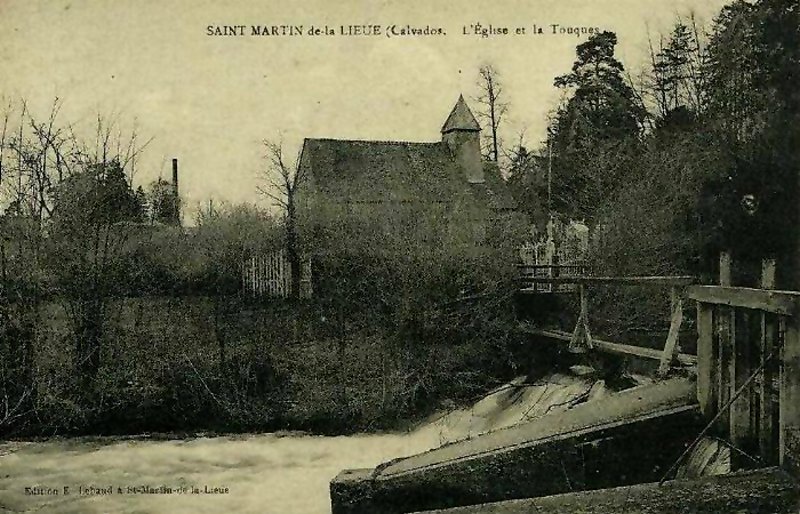 Saint Martin de la Lieue: the church and the river, where Louis Martin often fished Photo credit: Wikipedia
Saint Martin de la Lieue: the church and the river, where Louis Martin often fished Photo credit: Wikipedia
Desiree Toutain was born in the tiny hamlet of Saint-Hippolyte-des-Pres, near Lisieux, on May 27, 1817, the first child of Marc-Frédéric Toutain, 29, of Beuvilliers, a linen worker, and Luce-Victoire-Jacquette, Lepage, widow, 34, of Lisieux, "owner." They are farmers; perhaps the young widow had become the owner of farmland through the death of her first husband. The extended Toutain family was already well established as textile workers in Beuvillers. They had kept the faith throughout the French Revolution, and Desiree’s mother had saved the life of a persecuted priest. In 1821 Desiree’s parents gave her a little brother, Frederick Isidore, who would become the father of one of Therese’s Benedictine schoolteachers, Madame St. Benoit.[5] Desiree came from a hard-working family; she cannot have had many years of school, for the Carmel’s Chronicle mentions that “Sister Madeleine could barely write.” When the family faced money troubles, she had to leave her father’s house and go to her brothers in Paris; they hoped to find her a job there. As soon as she could, she returned to her father’s house, now in Saint-Martin-de-la-Lieue, which had absorbed the small hamlet where she was born. Like Sister Febronie, who entered four months before her, Desiree had taken Father Sauvage as her spiritual director. He recognized her vocation. But, devout as the family was, her father absolutely refused to approve her entering this new monastery, so poor and so austere. In the end, she ran away from his house just before her 25th birthday and was received as a postulant by Mother Genevieve, the new prioress, on Pentecost Sunday, May 15, 1842.
Sister Madeleine of the Blessed Sacrament
Sister Madeleine was made her way with the two other postulants and five novices then in formation. She received the habit on July 4, 1843 and made profession on July 10, 1844. Research yields only a little about her 49 years in Carmel. Unlike Sister Febronie, she did not live quite long enough to celebrate her 50th jubilee, so we can’t deduce anything from any songs written for that occasion. The foundation’s Chronicle reports that she was as good as gold:
My Sister Madeleine with her character that was a bit lively made amends with a heart of gold and deep humility. She was so charitable, so good for the sick, not sparing herself when it came to spending the night near them. Such an excellent judgment that even her Prioresses asked for her opinion.[6]
Sister Madeleine as cook: the miracle of the butter
Sister Madeleine served the community as its cook, and the monastery was so poor that she was often hard pressed to feed the nuns.
One day, the cook [Sister Madeleine] came to tell [Mother Genevieve] that the supply of butter was exhausted. “My child, I haven’t a farthing,” she answered quietly, “but if there is a little butter still left, go on using it, and let us put our trust in God.” From the moment the prodigy of Elias was repeated, and Sister Madeleine, even more astonished than was the widow of Sarepta at the sight of her inexhaustible pot of flour, came at the end of two months to her Prioress, saying: “Mother, I really can’t understand it; my little piece of butter is always in the same state! What does it mean? I had only enough for two days, and now, however much I use, it never grows less.” Be at peace,” was the answer, “your little stock is on the point of being finished.” And, in fact, some days later an alms was given to the Convent and Sister Madeleine found the pot empty.[7]
Click to see a period photo of a corner of the kitchen where Sister Madeleine worked.
Therese’s sister Marie of the Sacred Heart and Sister Madeleine
Therese’s sister Marie of the Sacred Heart, who often helped in the garden, mentions Sister Madeleine twice in letters to her father:
[I am] a very good gardener, whatever Sr. Madeleine says. This evening at recreation, the two of us had such fun (teasing each other). She says I burn my cuttings in the sun. It doesn’t surprise me, for she soaks hers every night in a bucket of cold water to get them to take root, so she finds my method funny.
Well, it was like the story of the two Invalids… do you remember? I said to her: “Sr. Madeleine, I accustom my flowers to hardship, they know me… the strongest survive; my cuttings and I resemble each other, we muddle through, thanks to God.[8]
Again, when Louis had given the monastery one of his frequent gifts of a big catch of fish:
Thank you darling Father! Thank you, thank you! More lovely fish… you lavish us with too many gifts. . . . .
Sr. Madeleine is delighted, she serves us portions worthy of “Mère Fanchon[9]”. It’s really filling! And there are no stocking-sized portions.[10]
Sister Madeleine’s remark: a great grace for Therese
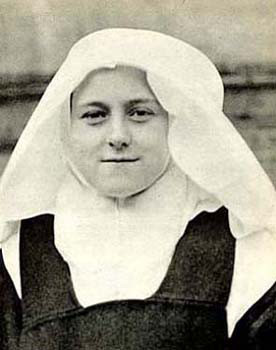 Therese as a novice, the month before this conversation took place
Therese as a novice, the month before this conversation took place
Sister Madeleine, with a “heart of gold,” looked out especially for the novices, and Pauline reports that, in 1897, Therese recalled a remark Sister Madeleine had made which, juxtaposed with a contrary remark by another lay-sister, impressed Therese deeply and was the occasion of a significant blessing for her. The conversation took place in February 1889, when Therese was 16. The “Yellow Notebook” of Sister Agnes of Jesus says that on July 25, 1897 Therese said to Sister Agnes (her sister Pauline):
Listen to this little, very funny story: One day, after I received the Habit, Sister St. Vincent de Paul saw me with Mother Prioress, and she exclaimed: 'Oh! how well she looks! Is this big girl strong! Is she plump!' I left, quite humbled by the compliment, when Sister Magdalene stopped me in front of the kitchen and said: 'But what is becoming of you, poor little Sister Thérèse of the Child Jesus! You are fading away before our eyes! If you continue at this pace, with an appearance that makes one tremble, you won't observe the Rule very long!' I couldn't get over hearing, one after the other, two such contrary appraisals. Ever since that moment, I have never attached any importance to the opinion of creatures, and this impression has so developed in me that, at this present time, reproaches and compliments glide over me without leaving the slightest imprint.[11]
“An expression of joy and peace covered the faces” of the dead
As Sister Madeleine was the last sister whom Therese saw in death during the epidemic, let’s look again at Therese’s reaction to the appearance of her sisters after they died:
It was without effort that the dying passed on to a better life, and immediately after their death an expression of joy and peace covered their faces and gave the impression almost that they were only asleep. Surely this was true because, after the image of this world has passed away, they will awaken to enjoy eternally the delights reserved for the Elect.[12]
Seeing this expression three times in six days on the faces of the women with whom she had lived made a deep impression on Therese, then scarcely 19, and confirmed her childhood belief that death was the gateway to eternal joy. One can hear an echo of what Louis and Zelie often repeated: “Oh, the Homeland! the Homeland!”
Sister Madeleine’s death circular; the double funeral for her and Sister Febronie on January 8
The funeral Mass for Sister Febronie suddenly became a double funeral for Febronie and Madeleine, who had entered only four months apart in 1842. The friends of the Carmel were shocked, on arrival, to find two coffins! By this time almost the whole community was sick in bed. Only six or seven of the twenty-two surviving nuns were able to attend the funeral, and then at a cost of great effort on their part. Mother Gonzague, still in the infirmary, wrote the briefest of circulars.
Soul of faith and devotion, We will stop, my Reverend Mother. We are so broken that it would be impossible for us to write of the untiring devotion of this heart, as big as it was generous in the service of God and her mothers and sisters.[13]
I encourage you to visit Sister Madeleine’s circular on the Web site of the Archives of the Carmel of Lisieux to read the touching words Madeleine herself left as a farewell to her prioress and her sisters.
Mother Gonzague continued:
Our venerable Mother Geneviève seemed to have wanted to call the three eldest of her daughters! If there is rejoicing in Heaven, there is sadness in Carmel!...
What heartbreak for us to see to see this morning coming out of our dear cloister, these two coffins that ourselves were not able to be around, being detained in the infirmary.[14]
She signed herself “from death’s garden.”
Click to see the enclosure door, through which the two coffins were carried that morning.
Sister Madeleine of the Blessed Sacrament was the last of the three elders God called during the influenza epidemic. The sick nuns began to recover slowly. In Part 7, we will look at Therese’s experience of the Eucharist during the epidemic.
[1] The Carmelites usually did not enter another nun’s cell.
[2] Story of a Soul, 3rd ed., tr. John Clarke, O.C.D. Washington, D.C.: Washington Province of Discalced Carmelite Friars, 1996, p. 171.
[3] Biographie de Soeur Madeleine, Web site of the Archives of the Carmel of Lisieux at http://www.archives-carmel-lisieux.fr/carmel/index.php/les-bonnes-vieilles/madelein-du-st-sacrement/biographie, accessed 6/7/2020.
[4] Story of a Soul, op. cit., p. 171.
[5] On Tuesday, January 5, after the funeral Mass of Sister Saint-Joseph, Celine Martin wrote to her cousin Jeanne LaNeele: “There are still two of the three sick ones whom they despair of saving, among them Sister Madeleine, aunt of Madame St. Benoît at the Abbey, and another religious whom I do not know.” [Celine must have been referring to the most severely ill when she says ‘three,” for 13 sisters were already ill as of December 31]. This letter is on the Web site of the Archives of the Carmel of Lisieux at http://archives-carmel-lisieux.fr/english/carmel/index.php/celine-martin-soeur-genevieve/2809-de-celine-a-jeanne-la-neele-5-janvier-1892, accessed 6/5/2020.
[6] See the appendix to Sister Madeleine’s obituary circular at http://archives-carmel-lisieux.fr/english/carmel/index.php/les-bonnes-vieilles/madelein-du-st-sacrement/circulaire-de-madeleine-du-st-sacrement, accessed 6/9/2020.
[7] The Foundation of the Carmel of Lisieux and the Reverend Mother Genevieve of St.Teresa, tr. by a Religious of the Society of the Holy Child Jesus. Calvados, France: Carmel of Lisieux; London, St. Anselm Society; Philadelphia, Pa., Carmelite Convent, 1913, pp. 88-89.
[8] Letter of Sister Marie of the Sacred Heart to her father, Louis Martin, August 23, 1887 at http://www.archives-carmel-lisieux.fr/english/carmel/index.php/aout-1887/5143-de-marie-marie-du-sacre-coeur-a-son-pere-m-martin-23-aout-1887, accessed 6/7/2020.
[9] I believe this is a literary allusion, perhaps to a story they’d read at Les Buissonnets.
[10] Letter of Sister Marie of the Sacred Heart to her father, M. Martin, second half of 1887 at http://www.archives-carmel-lisieux.fr/english/carmel/index.php/marie-martin-marie-du-sacree-coeur-msc/5070-de-marie-marie-du-sacre-coeur-a-son-pere-m-martin-deuxieme-semestre-1887, accessed 6/7/2020.
[11] St. Therese of Lisieux: Her Last Conversations, tr. John Clarke, O.C.D. Washington, D.C.: Washington Province of Discalced Carmelites, Inc., 1977, pp. 111-112.
[12] Story of a Soul, op. cit., p. 172. Note that, although the Clarke translation writes that the expressions of the dead women gave the impression “almost that they were only asleep,” the French reads “on aurait dit un douce sommeil,” that is, gave the impression of “a sweet sleep” (our italics).
[13] Circular of Sister Madeleine of the Blessed Sacrament, Web site of the Archives of the Carmel of Lisieux, http://www.archives-carmel-lisieux.fr/english/carmel/index.php/les-bonnes-vieilles/madelein-du-st-sacrement/circulaire-de-madeleine-du-st-sacrement, accessed 6/7/2020.
[14] Ibid.
St. Therese of Lisieux and the influenza pandemic of 1892, part 5: the subprioress, Sister Febronie of the Holy Childhood
Sister Febronie of the Holy Childhood (1819-1892),
subprioress, the second to die during the pandemic
We left the Lisieux Carmel after the death of the first victim of the influenza epidemic, Sister Saint-Joseph of Jesus, who died on Saturday morning, January 2, 1892. Her funeral had been set for the morning of Tuesday, January 5, and her body laid out, according to custom, in the choir. But the evening before her funeral Mass God called another elder of the community, Sister Febronie of Jesus, the subprioress, who died at 8:00 p.m. on Monday, January 4th. The next morning Celine Martin wrote to her cousin, Jeanne LaNeele:
The poor Carmel is right now a prey to the influenza epidemic, the plague is raging there in full force. This morning we were at the burial of the religious who died on Saturday, and on Friday we shall return for another burial, that of the Mother Subprioress, who died last night. There are still two of the three sick ones whom they despair of saving, among them Sister Madeleine, aunt of Madame St. Benoît at the Abbey, and another religious whom I do not know. Up until now, it is the older ones who are leaving, but the young are also very sick. Pauline has been in bed for a few days now . . . [1]
Read the full text of this letter on the Web site of the Archives of the Carmel of Lisieux.
Let’s look first at a brief summary of Sister Febronie’s life. More details can be found on the page “Sister Febronie of the Holy Childhood” on the Web site of the Archives of the Carmel of Lisieux. I thank the Carmelites of Lisieux for sharing all this information.
Marie-Julie Malville
Marie-Julie Malville, known as Julie, was born in Paris on October 31, 1819, the daughter of a tailor. Her sister Pauline was born 16 months later. Their mother, Marie-Jeanne Paris, died when Julie was only five. At first the father had to entrust the two little girls to a friend of their mother’s, but he soon remarried and moved his family to Rouen, where Julie and Pauline were placed in a convent boarding school. Julie developed a passion for study; she did not want to leave her books even to play the customary games. Later the family moved to Lisieux, where Julie encountered Carmel.
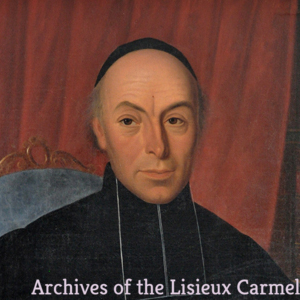 Fr. Pierre-Nicolas Sauvage, priest-founder of the Lisieux CarmAbout 1838, in the neighborhood of the Nouveau Monde, outside Lisieux and near Les Buissonnets, Fr. Pierre-Nicolas Sauvage, curate of Saint Jacques parish in Lisieux, would sometimes meet the two Malville girls and their mother returning from church. Thinking of the monastery he had just founded, he wondered whether one of them might be a future Carmelite. One day the two girls came to his confessional, and he became Julie’s spiritual director. When she learned that he was the priest-superior of the Carmelites, her early thoughts of religious life returned to her. Fearing that Julie's health would not support the austere rule of Carmel, Fr. Sauvage tried to persuade her against it, but finally he allowed her to present herself to the Carmelites. At the end of 1841 she was received as a visitor by the prioress, Mother Elizabeth of St. Louis, who had hardly blessed the candidate when she herself was called to God on January 3, 1842. Like Therese, Mother Elizabeth died of tuberculosis.
Fr. Pierre-Nicolas Sauvage, priest-founder of the Lisieux CarmAbout 1838, in the neighborhood of the Nouveau Monde, outside Lisieux and near Les Buissonnets, Fr. Pierre-Nicolas Sauvage, curate of Saint Jacques parish in Lisieux, would sometimes meet the two Malville girls and their mother returning from church. Thinking of the monastery he had just founded, he wondered whether one of them might be a future Carmelite. One day the two girls came to his confessional, and he became Julie’s spiritual director. When she learned that he was the priest-superior of the Carmelites, her early thoughts of religious life returned to her. Fearing that Julie's health would not support the austere rule of Carmel, Fr. Sauvage tried to persuade her against it, but finally he allowed her to present herself to the Carmelites. At the end of 1841 she was received as a visitor by the prioress, Mother Elizabeth of St. Louis, who had hardly blessed the candidate when she herself was called to God on January 3, 1842. Like Therese, Mother Elizabeth died of tuberculosis. 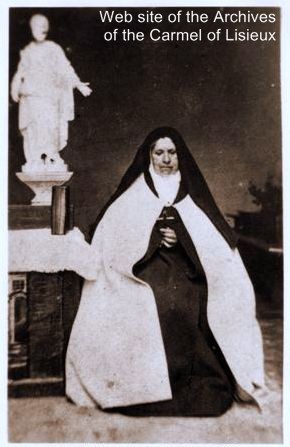 Mother Genevieve of St. Teresa, who received Julie Malville into the CarmelHer successor, Mother Genevieve of St. Teresa, received Julie on the day she was elected prioress: January 15, 1842. Julie was the eighth postulant since the Carmel had opened in 1838.
Mother Genevieve of St. Teresa, who received Julie Malville into the CarmelHer successor, Mother Genevieve of St. Teresa, received Julie on the day she was elected prioress: January 15, 1842. Julie was the eighth postulant since the Carmel had opened in 1838.
In Carmel: Sister Febronie
Julie, now Sister Febronie of the Holy Childhood, adapted well to Carmelite life. In her circular Mother Gonzague wrote that she
“was from her entrance a model of regularity, of silence and of piety. This was truly an interior soul who loved solitary life and to be hidden in God. Our good older Mothers recognizing the young religious as someone filled with qualities that bring joy and hope to the community, received her with happiness . . .”[2]
She received the habit on May 24, 1842 and professed her vows on July 15, 1843. 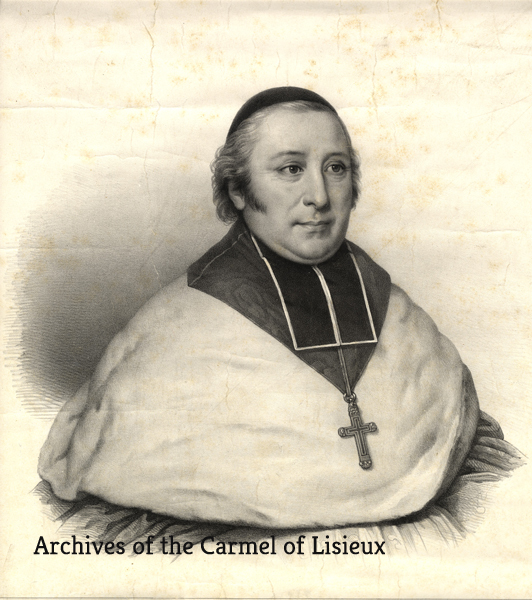 Francois Robin, bishop of BayeuxHer taking of the veil was postponed until October 27th so that the bishop, Francois Robin, might preside. Although the documents hint that M. Malville had not been eager to consent to his daughter’s entrance, at her taking of the veil the bishop noticed him at the grille asking Julie’s forgiveness and offering her his own. He was generous in gifts to the desperately poor community.
Francois Robin, bishop of BayeuxHer taking of the veil was postponed until October 27th so that the bishop, Francois Robin, might preside. Although the documents hint that M. Malville had not been eager to consent to his daughter’s entrance, at her taking of the veil the bishop noticed him at the grille asking Julie’s forgiveness and offering her his own. He was generous in gifts to the desperately poor community.
Sister Febronie was appointed by turns infirmarian, laundress, and dressmaker. In 1860, she was elected subprioress. In this role she served off and on for a total of 14 years; she was subprioress from Therese’s entrance until her own death. Mother Gonzague wrote that, as subprioress, Sister Febronie “was the happiness and joy of her Mother Prioresses, remaining always united with them in the same views and feelings.”[3] (These prioresses were Mother Genevieve and Mother Gonzague).
When the Franco-Prussian war of 1870 came close to Lisieux, the families of some of the nuns asked to be allowed to take their daughters home to keep them safe. Sister Febronie’s family, now living in Rennes, offered her refuge, but she preferred the Carmel of Rennes, which had already taken in the whole Carmelite community of Compiegne. There they preserved “a good remembrance” of her.[4]
Sister Therese as a novice and Sister Febronie
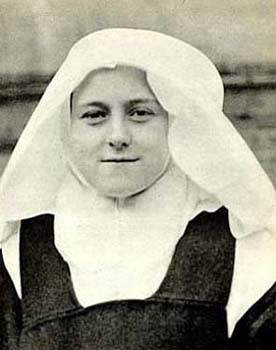 Sister Therese of the Child Jesus as a novice, aged 16, January 1889In Story of a Soul, without naming Sister Febronie, Therese gives an account of their conversation during recreation. It was during her first two years in Carmel, when she was having difficulty confiding in her novice mistress, Marie of the Angels:
Sister Therese of the Child Jesus as a novice, aged 16, January 1889In Story of a Soul, without naming Sister Febronie, Therese gives an account of their conversation during recreation. It was during her first two years in Carmel, when she was having difficulty confiding in her novice mistress, Marie of the Angels:
It was only with great effort that I was able to take direction, for I had never become accustomed to speaking about my soul and I didn’t know how to express what was going on within it. One good old Mother understood one day what I was experiencing, and she said laughingly during recreation: “My child, it seems to me you don’t have very much to tell your Superiors.” “Why do you say that, Mother?” “Because your soul is extremely simple, but when you will be perfect, you will be even more simple; the closer one approaches to God, the simpler one becomes.” The good Mother was right . . . . [5]
Sister Febronie during the influenza epidemic
The epidemic of influenza made it necessary for Sister Febronie to step quickly into the prioress’s role. Sister Febronie was not one of the first affected by influenza. Twelve others, including Mother Gonzague, were already very ill when, as the monastery’s documents attest, on New Year’s Eve 1891 Sister Febronie, as subprioress, had just escorted Dr. de Corniere to the enclosure door when she suddenly felt herself stricken. It’s worth noting that Sister Febronie, then 72, died only four days later. The pandemic was truly deadly. Mother Gonzague wrote that, as Sister Febronie lay dying, she called for her prioress. “Our good Mother Sub-Prioress heroically accepted her trial, crying out in her agony, “Yet another sacrifice!...O my Jesus, I offer this to you…” In Sister Febronie’s circular you can read more of Mother Gonzague’s distress at being unable to accompany any of her three daughters in their last moments.
The Bridegroom came for Sister Febronie on Monday, January 4, at eight o’clock in the evening. Therese was present. She tells us:
The night Mother Subprioress died I was all alone with the infirmarian[6]. It’s impossible to imagine the sad state of the community at this time; the ones who were up and about can give some idea of the conditions, but in the midst of this abandonment I felt that God was watching over us. It was without effort that the dying passed on to a better life, and immediately after their death an expression of joy and peace covered their faces and gave the impression almost that they were only asleep. Surely this was true because, after the image of this world has passed away, they will awaken to enjoy eternally the delights reserved for the Elect.[7]
Since Therese speaks of “their faces," and since we know that she did not witness the death of the third nun, Sister Madeleine of the Blessed Sacrament, we can infer that she had been present at the death of Sister Saint-Joseph on Saturday morning. Since the chaplain was with Sister Saint-Joseph in her final hours, it is clear that the Carmelites knew that she was near death, so it’s all the more likely that Therese was with her. Observing that the dying women made their transition “without effort” and seeing the “expression of joy and peace” that covered their faces deeply moved Therese, confirming the belief she had formed from being present at the death of the Carmel’s saintly founder that death was nothing to fear.[8]
Therese’s attitude toward death
Indeed, for the rest of her life Therese’s attitude toward death was not only matter-of-fact but also joyous. Sister Marie of the Angels, her novice mistress, testified:
She did not fear death, which, she said, was “the only way to reach God.” Nor was she afraid of purgatory, saying that it was “the least of her worries.”[9]
Sister Therese of St. Augustine, the nun for whom Therese felt a strong natural antipathy but whom she befriended, testified that Therese
“spoke to me many times about her desire to die, and her eyes shone with happiness every time the subject was brought up . . . . The thought of her approaching death brought her only joy and hope.”
She also reported that Therese was in the habit of saying
"I cannot understand why people get so upset when they see their Sisters die; we are all going to heaven and we will meet one another there again.”[10]
Sister Febronie and Therese: divine justice or infinite mercy?
Another conversation between Sister Febronie and Sister Therese was recorded by Marie of the Angels, who dates it at the end of 1891, after Therese’s liberating conversation with Fr. Alexis Prou in October:
Sister Therese of the Child Jesus knew Sister Febronie perfectly. It’s a saying of this good Sister that I am quoting to you . . . . One day, our Angel and Sister Febronie were having a spiritual conversation together in which this venerated Sister, who was a little fearful, defended to excess the claims of divine justice, and our angel, those of infinite mercy, but the latter, seeing that she was getting nowhere and still remaining in her opinion, ended by saying [to Sister Febronie] seriously, and we might almost say divinely: “Sister, if you want God’s justice, you will get God’s justice. The soul receives exactly what it expects from God.”
After her death Sister Febronie appears once more in Therese’s story in a postlude to this conversation. Marie of the Angels continues:
But the year when this sister died in the first days of January [1892], on the day of the feast of St. Julie [May 22], Sister Febronie’s patron saint for her baptism, Sister Therese of the Child Jesus saw in a dream a procession of Carmelites, among whom was Sister Febronie . . . She turned her head sadly and, without saying anything, fixed on our holy child a long and sad gaze! Her attitude was pleading, much more expressive than any words. This dream was reported to our Mother [Gonzague]; it had greatly impressed the little apostle of love and mercy: “O Mother,” she said to her, “Sister Febronie came to me tonight to ask us to pray for her; she is probably in Purgatory, for not having counted enough on the Mercy of God! By her pleading air and her profound gaze, she seemed to be saying to me: “You were right, all justice has been served on me, but it is my fault; if I had believed you, I would have gone straight to heaven!”[11]
Sister Febronie was considered a good and holy nun, much loved by her superiors and her sisters. She was elected subprioress several times, and Therese called her a “good old Mother.” It is difficult to imagine what serious sins she could have committed in almost 50 years in the Lisieux Carmel. Therese’s statement “If you want God’s justice, you will have God’s justice” and her interpretation of her dream raise the question of whether, since God is free, the operation of God’s mercy can be constrained by the attitude of a human being toward that mercy. Could “purgatory” here be the process of being purified from all fear? Nevertheless, both the conversation and the dream serve to underscore the crucial importance Therese attached to the soul’s confidence in God. The dream might have been Therese’s unconscious mind revealing to her the vital role of confidence, or one might call it a posthumous gift from God to Sister Febronie, allowing her to confirm to Therese the rightness and significance of the way of confidence and love Therese would discover two and a half years later. Since Sister Febronie died at the very beginning of 1892, her novice mistress's account of the conversation and the dream make clear that Therese emphasized confidence as early as 1891, when she was only 18. Further, even as a young professed speaking to her elderly subprioress, Therese was prepared to insist on God’s infinite mercy and on the confidence with which we should respond to it. About five years later, after having discovered her way of confidence and love, Therese would write to her sister Marie “It is confidence, and nothing but confidence, that must lead us to love.”
[1] Letter of Celine Martin to Jeanne La Neele, January 5, 1892, at the Web site of the Archives of the Carmel of Lisieux, http://archives-carmel-lisieux.fr/english/carmel/index.php/celine-martin-soeur-genevieve/2809-de-celine-a-jeanne-la-neele-5-janvier-1892, accessed 6/4/2020.
[2] Circular of Sister Febronie of the Holy Childhood on the Web site of the Archives of the Carmel of Lisieux, http://archives-carmel-lisieux.fr/english/carmel/index.php/les-bonnes-vieilles/f%C3%A9bronie/circulaire-de-f%C3%A9bronie, accessed 6/4/2020.
[3] Ibid.
[4] Ibid.
[5] Story of a Soul, 3rd ed., tr. John Clarke, O.C.D. Washington, D.C.: Washington Province of Discalced Carmelites, 1996, p. 151.
[6] Sister Aimee of Jesus, the first infirmarian. Although Sister Aimee was affected by influenza, she must have been well enough to help care for Sister Febronie at this time, for the prioress wrote that, since she herself, “detained in the infirmary,” could not help Sister Febronie, she “entrusted her to our devoted infirmarian.” Perhaps Sister Aimee of Jesus did not get sick until after Sister Febronie’s death.
[7] Story of a Soul, op. cit., p. 172.
[8] “125 Years Ago With Saint Therese: The Death of Mother Genevieve, founder of the Lisieux Carmel, on December 5, 1891,” by Maureen O’Riordan at http://www.thereseoflisieux.org/my-blog-about-st-therese/2016/12/4/125-years-ago-with-saint-therese-the-death-of-mother-genevie.html, accessed 6/4/2020.
[9] Testimony of Marie of the Angels, Apostolic Process, questions 22-26, [869]. http://archives-carmel-lisieux.fr/english/carmel/index.php/10-marie-des-anges, accessed 6/4/2020.
[10] St.Therese of Lisieux by those who knew her, ed. Christopher O’Mahony. Dublin: Veritas Press, 1975, p. 192.
[11] Preparatory notes [for the Process] of Sister Marie of the Angels, on the Web site of the Archives of the Carmel of Lisieux, http://www.archives-carmel-lisieux.fr/english/carmel/index.php/la-ma%C3%AEtresse-des-novices/marie-des-anges2/plusieurs-t%C3%A9moignages-de-marie-des-anges/notes-pr%C3%A9paratoires, accessed May 31, 2020. My translation. Translation copyright Maureen O’Riordan 2020. All rights reserved.
St. Therese of Lisieux and the influenza pandemic of 1892, Part 3: how the outbreak disrupted the Carmel, and the loss of "the good old Sisters"
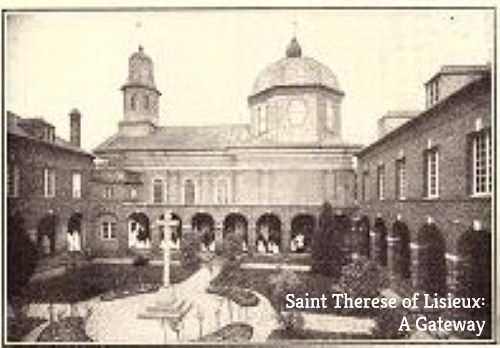 The nuns follow in procession as the Blessed Sacrament is brought to a sick nun in the Lisieux Carmel.
The nuns follow in procession as the Blessed Sacrament is brought to a sick nun in the Lisieux Carmel.
How the influenza pandemic disrupted the community life of the Lisieux Carmel
We adjourned on Sunday, January 2, 1892, when, five days after the epidemic reached the Carmel, Sister Saint-Joseph of Jesus died. I want to look for a moment at how dramatically life at Carmel had changed between Tuesday, December 28, 1891, when the first nuns got sick, and Saturday, January 2, when Sister Saint-Joseph, the first fatality, died. The monastery’s chronicle reads, in part:
“The influenza epidemic raged in our region with force. On December 28, Holy Innocents, several of our sisters had to take to their beds. When we saw our good Sister St. Joseph, eighty-three, seized by this terrible sickness, we had no doubt that the Lord would find her ripe for heaven. We then mourned the departure of Mother Subprioress, Sister Febronie of the Holy Childhood, and Sister Madeleine: three coffins in eight days! . . . . Our Reverend Mother was very sick, all our sisters confined to bed; never in the annals of our Carmel had we seen the like. At the burial of our two Sisters, hardly six or seven were present, and then at the cost of a great effort on their part! Only the three youngest of the entire Community were not stricken by this epidemic . . . . What Community life! no more office in choir, no prayer, no reading in the refectory, no bells rung for religious exercises. Death was hanging over us! . . .” (Foundation III, p. 206). The three youngest were: Sister Marie of the Sacred Heart, infirmarian, Therese, sacristan, and Marthe, cook.
cited in Letters of Saint Therese of Llisieux, Volume II, 1890-1896, tr. John Clarke, O.C.D. (Washington, D.C.: Washington Province of Discalced Carmelites, 1988, p. 747, footnote 1).
In fact, there were three coffins in six days. By Sunday, December 31, half the community was sick in bed, and most of the others followed. It seems that Mass continued to be offered, but Therese and her sister Marie, the only choir sisters who were not sick in bed, could not continue to chant the Divine Office. For the first time, the community’s life was completely suspended, even more so than during the War of 1870 when many sisters returned to their families or sought refuge in other Carmels until they could safely return. Just as with us in 2020, the lives of the individual nuns and of the community were disrupted very suddenly.
All the nuns in positions of leadership were too sick to function. The prioress was confined to bed; the subprioress died; the other councilors were sick. Everything fell on the three youngest sisters, who cared for the sick, washed the dead and prepared them for burial, and communicated with the doctor, the chaplain, and the outside world. Such communications were more frequent when three funerals had to be arranged and when, while the epidemic raged in Lisieux, the requests for prayers must have multiplied. Sister Stanislas, the first sacristan, was among the stricken, and Therese had to prepare the sacred vessels, open the grilles for Mass, and arrange the funerals.
After we have examined all the events of the pandemic at Carmel, we shall return to the question of how Therese reacted to this disruption and what we can learn from her. Meanwhile, we will look at the three Carmelites who died in the first week of January 1892.
“The good old Sisters”
The marvelously informative Web site of the Archives of the Carmel of Lisieux, which I recommend highly, offers a section about the Carmelites who lived with Therese. The section divides the nuns into different groups. One such group is “the good old Sisters.” The Carmelites tell us that these elders were very helpful in integrating young women into the community, acting
“a bit like good grandmothers, acting as a buffer between the demands of the experienced sisters who keep the community running smoothly and even the management of the community. Having a little more time to themselves, whether because of infirmities or something else, they take care of the young in their own way, available for a smile, a kind word, for comfort.”
The members of this group were Mother Genevieve of St. Teresa, Sister Saint-Joseph of Jesus, Sister Febronie of the Holy Childhood, and Sister Madeleine of the Blessed Sacrament. On December 4, 1891, all of them were living. By January 7, 1892, all four were dead. Thus, the pandemic not only killed three of the 25 nuns—one of almost every eight women in the community—but also, together with the death in December of the founder, Mother Genevieve, stripped away an entire layer of the community: its wisdom figures, including the only two living connections with its foundation in 1838. Except for Mother Genevieve, we will hear little of them later on. But, for her first three years and nine months in Carmel, Therese had lived with all of them. Their lives, as well as their deaths, affected her and the whole community, so I want to examine them. Part 4 of this series will consider the life and death of Sister Saint-Joseph of Jesus, the first postulant of the Lisieux Carmel.
___________________________________________________
 The extract from the monastery's chronicle above, which depicts what life was like in the Lisieux Carmel during the outbreak, is only one of many gems in the second volume of Therese's letters. This book is one of the very best ways to get to know Therese, the people with whom she lived, and the world in which she lived. Although the volume is not brief, it's easy, if you like, to begin only with Therese's letters and to skip over those written by others until they come to interest you. The introductions to each section, referring you to the relevant passages in Story of a Soul, and the notes make the book much more readable. Although Story of a Soul has the grace of emotion recollected in tranquility, the letters are immediate and spontaneous.
The extract from the monastery's chronicle above, which depicts what life was like in the Lisieux Carmel during the outbreak, is only one of many gems in the second volume of Therese's letters. This book is one of the very best ways to get to know Therese, the people with whom she lived, and the world in which she lived. Although the volume is not brief, it's easy, if you like, to begin only with Therese's letters and to skip over those written by others until they come to interest you. The introductions to each section, referring you to the relevant passages in Story of a Soul, and the notes make the book much more readable. Although Story of a Soul has the grace of emotion recollected in tranquility, the letters are immediate and spontaneous.
St. Therese and the influenza pandemic in the Lisieux Carmel, 1891-1892
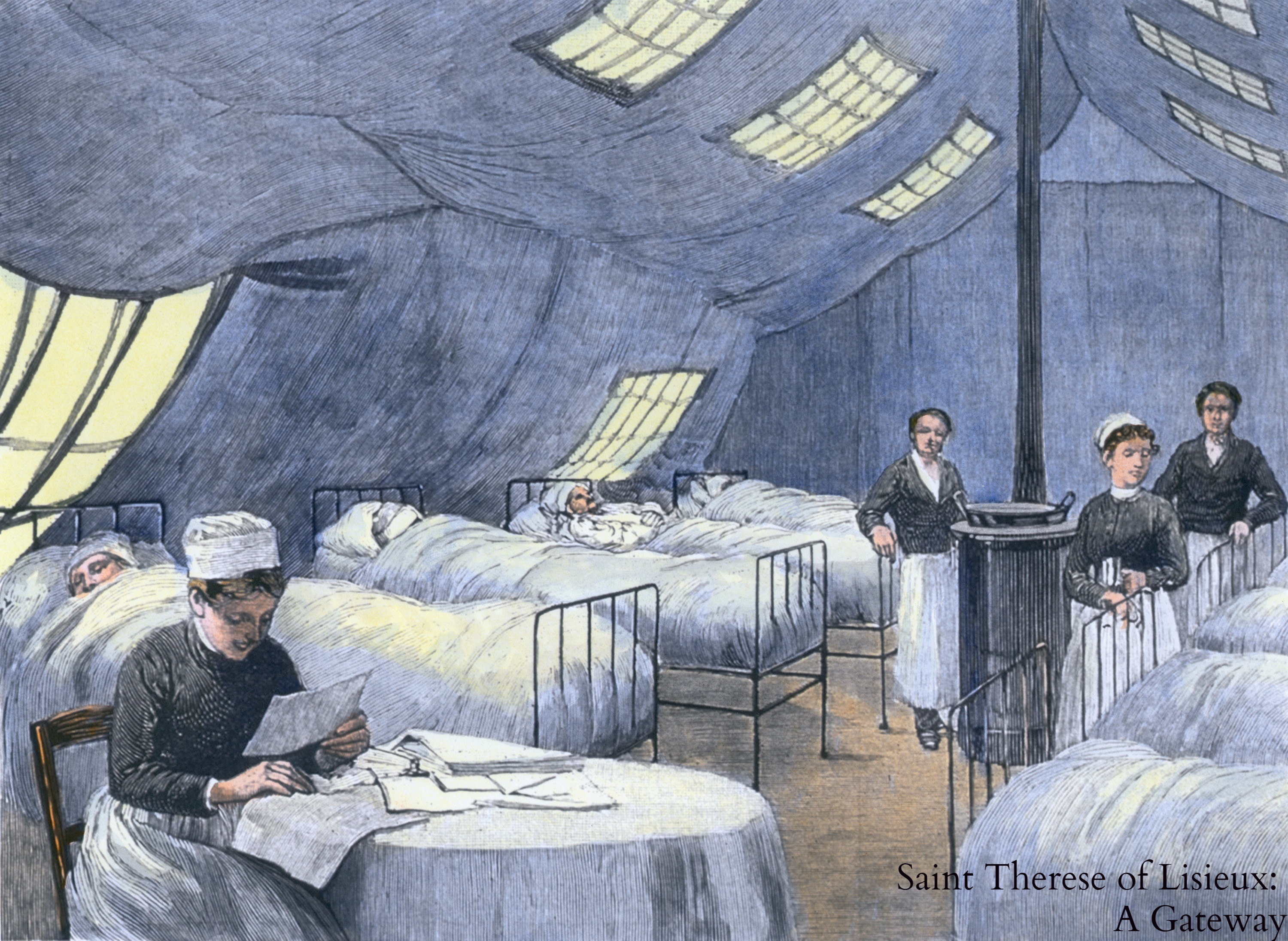
Asian Flu epidemic of 1889-90 In Paris patients are treated in a supplemental tent hospital A nurse attends to several patients during the winter of 1889-90.
St. Therese of Lisieux and the Influenza Pandemic of 1891-1892
Part 2: Context
Saint Therese of Lisieux also lived through a sudden and deadly pandemic in 1891-1892. In 2020, what can we learn from how she responded?
The external facts are simple: a pandemic of influenza swept the world, reaching the Carmelite monastery in Lisieux just after Christmas in 1891. Only the three youngest of the 25 nuns (including Therese, then 18) escaped infection. In six days, the three oldest nuns in the community died of it. During the epidemic, Therese took on many new responsibilities. In her memoir she wrote briefly but eloquently about this experience.
The “Asiatic flu” pandemic
The pandemic that affected the Lisieux Carmel was a recurrence of the deadly “Asiatic flu” or “Russian flu” pandemic first reported in Russia in 1889. The last great pandemic of the 19th century, it killed more than a million patients around the world. The pandemic was heavily covered in the newspapers, which sound eerily reminiscent of today: hospitals so overcrowded that they pitch tents in public parks; the funeral homes unable to cope with the many dead.
Although airplane travel was not in question, the epidemic circled the globe in four months. This influenza peaked in St. Petersburg on December 1, 1889 and in the United States during the week of January 12, 1890. The first outbreak ravaged France at the end of 1889 and the beginning of 1890. It recurred several times from 1891-1895: the outbreak at Lisieux was part of the second recurrence.[i] Influenza invaded the Carmel right after Christmas in 1891.
The context of Therese’s life at that time
The time leading up to the pandemic contained only a few important events for Therese. (See my page “The Hidden Years”). Since February 12, 1889 her father Louis had been interned in a mental asylum, the Bon Saveur, in Caen. Her sisters Leonie and Celine had joined the household of their maternal uncle and aunt, Isidore and Celine Guerin, in Lisieux. Every week they visited their three sisters in Carmel and their father at the Bon Sauveur. Although Therese did not know it yet, Louis would return to Lisieux permanently in May 1892.
Professed on September 8, 1890, Therese was still living in the novitiate for the three years of continuing formation then customary for the recently vowed. Her sisters Marie and Pauline were her seniors in Carmel. Mother Marie de Gonzague was prioress, as she had been since Therese’s entry. About February 10, 1891,[ii] Therese was named assistant to Sister Stanislaus of the Sacred Hearts [of Jesus and Mary][iii], the sacristan, who, because Therese was slow in finishing her tasks, affectionately nicknamed her “Little Sister Amen.” During the epidemic Therese was second sacristan.
In these same months the life of the community had been relatively quiet. During the rainy summer of 1891, Mother Genevieve of St. Teresa, revered as the founder of the Lisieux Carmel, celebrated her diamond jubilee (the 60th anniversary of her profession) on July 22.[iv] The next day Celine refused her persistent suitor, Henry Maudelonde.[v] On September 11, Isidore and Celine Guerin celebrated their silver wedding anniversary.[vi] In October (probably from October 7 through October 15), Fr. Alexis Prou, a Franciscan priest, preached the community’s annual retreat. Therese’s encounter with him in the confessional was liberating for her [Web site of the Lisieux Carmel Archives]; later, she would write “He launched me full sail upon the waves of confidence and love . . . .” That same week, on October 10, Fr. Maurice-Joseph Reverony, Bishop Hugonin’s vicar-general, who had introduced Therese and her father to the bishop at Bayeux on October 31, 1887 and had presented the Martins to Pope Leo XIII on November 20, 1887, died at Caen.[vii] In the end, he had been instrumental in opening the doors of Carmel to Therese. On November 24, 1891, the community celebrated the tricentenary of the death of St. John of the Cross.[viii] That anniversary was marked by a resurgence of interest in John in France, and Therese later wrote: “At the ages of seventeen and eighteen, I read no one else.”[ix] Fr. Deodat de Basly, a Franciscan, preached a triduum, and Bishop Hugonin entered the cloister and showered Therese with caresses.
Mother Genevieve of St. Teresa dies
On December 5, 1891, Mother Genevieve died. It was the first time Therese had seen someone die. She wrote:
“It was the first time I had assisted at a death and really the spectacle was ravishing . . . at the moment itself of our saintly Mother Genevieve’s birth in heaven . . . . in the twinkling of an eye I experienced an inexpressible joy and fervor; it was as though Mother Genevieve had imparted to me a little of the happiness she was enjoying, for I was convinced she went straight to heaven.”[x]
Mother Genevieve was truly venerated as a saint; even Dr. de Corniere, when he extracted a tooth from her mouth, kept it as a relic.[xi] As was usual in Carmel, when Mother Genevieve entered into her agony the community gathered at her bedside to help her with their prayers; Therese was placed at the foot of Mother Genevieve’s bed, where she remained for two hours, until the founder died. Witnessing this death might well have prepared Therese for the experience of the deaths of three lesser known sisters, under very different circumstances, only a few weeks later. These nuns died not in the infirmary, but in their cells; almost all the sisters were sick, and “as soon as a Sister breathed her last, we were obliged to leave her alone.”[xii] We shall return to Therese’s experience of death during the epidemic. .
In a growing trend toward secularism in France, the civil authorities had begun to refuse to allow religious communities to bury their deceased members on their own grounds. Fearing that the body of the founder would not be left with them, the nuns decided to preserve her heart in formaldehyde so that they would have one major relic at least near which to pray. In the end, after a delay of several weeks, the town council consented to a burial "in house," and Mother Genevieve’s body was entombed in the sanctuary of the Carmel chapel on December 23.[xiii]
The pandemic ravages the Carmel
Five days later, influenza came to the Carmel. According to the Chronicle of the Foundation, on December 28, the feast of the Holy Innocents, several nuns had to take to their beds.[xiv] By December 31, 12 of the 25 nuns were sick.[xv] Dr. de Corniere, who would later treat Therese in her last sickness, was overwhelmed with work, but he came twice a day to care for the Carmelites.[xvi] On the evening of December 31, Sister Febronie of the Holy Childhood, subprioress, showed her first symptoms as she returned from escorting Dr. de Corniere to the enclosure door.[xvii] On January 2, 1892, Therese’s 19th birthday, Sister St. Joseph of Jesus, the oldest nun in the house and the first postulant of the Lisieux community, died.[xviii]
For the rest of the story, stay tuned.
For Part 1 of this series, a timeline of the influenza pandemic at Lisieux Carmel, click the blue button:
Notes:
[i] Wikipedia, “1889-1890 flu pandemic.” https://en.wikipedia.org/wiki/1889%E2%80%931890_flu_pandemic, accessed 5/19/2020.
[ii] Story of a Soul, 3rd edition, tr. John Clarke, O.C.D. (Washington, D.C.: Washington Province of Discalced Carmelites, Inc., 1996, p. 283).
[iii] For more about Sister Saint Stanislas, including her brief statement in 1906 about her observations of Therese’s virtue, see http://www.archives-carmel-lisieux.fr/english/carmel/index.php/les-soeurs-dexperience/stanislas-des-sts-coeurs/circulaire-de-stanislas
[iv] Letters of St. Therese of Lisieux, Volume II, 1890-1897. Tr. John Clarke, O.C.D. (Washington, D.C.: Washington Province of Discalced Carmelites, 1988, p. 733, note 1).
[v] Letters, Volume II, p. 733, note 2.
[vi] Letters, Volume II, p. 735
[vii] Letters, Volume II, p. 1316
[viii] Letters, Volume II, p. 737.
[ix] Story of a Soul, p. 179.
[x] Story of a Soul, p. 170.
[xi] Sainte Therese de Lisieux (1873-1897), by Guy Gaucher, O.C.D. (Paris: Editions du Cerf, 2011, p. 349).
[xii] Story of a Soul, p. 171.
[xiii] Sainte Therese de Lisieux (1873-1897), Gaucher, p. 349.
[xiv] Cited in Letters, Volume II, p. 747, note 1.
[xv] "Biography of Sister Febronie of the Holy Childhood," http://www.archives-carmel-lisieux.fr/english/carmel/index.php/les-bonnes-vieilles/f%C3%A9bronie/biographie, paragraph 7 of the section “With Therese,” accessed 5/19/2020.
[xvi] Gaucher, p. 351.
[xvii] Circular of Sister Febronie of the Holy Childhood, Web site of the Archives of the Carmel of Lisieux, http://www.archives-carmel-lisieux.fr/english/carmel/index.php/les-bonnes-vieilles/f%C3%A9bronie/circulaire-de-f%C3%A9bronie, accessed 5/19/2020.
[xviii] "Biography of Sister Febronie of the Holy Childhood," Web site of the Archives of the Carmel of Lisieux, http://www.archives-carmel-lisieux.fr/english/carmel/index.php/les-bonnes-vieilles/f%C3%A9bronie/biographie, accessed 5/19/2020.







